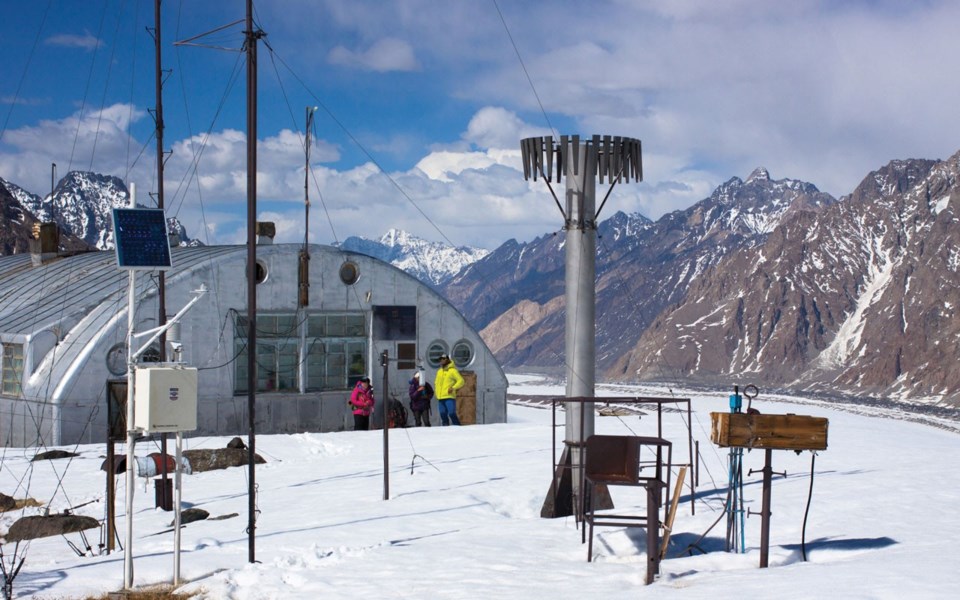"Comrade Stalin. Glad to be able to inform you that the highest point of the USSR, first discovered by us last year, and named after you, the beloved leader of the world proletariat, was reached on the 3rd September by our storming party. ... Our party sends you heartiest greetings. Gorbunov."
— Telegram sent from Osh, Kyrgyzstan by Nikolai Petrovich Gorbunov, Chief of the Executive of the Soviet of People's Commissars, 1933.
I duck my head as I step through the first bulkhead door and follow a short passage before clambering through an even smaller hatch. The entrance to the 80-year-old Gorbunov Meteorological Station was designed to keep out the harsh elements, not accommodate tall travelling ski mountaineers.
Inside to my left, a sad guitar lays on a stool, the rotting wood separating in several places. Posters of forgotten '80s action movies and classic bodybuilders adorn the walls, accompanied by Madonna in her prime. A pair of dried chicken feet is wedged above the entrance doorway, warding off thieves and other malevolent spirits. What I assume was once the common area features a wall map alongside pencilled portraits of ancient rulers from the Samanid dynasty. Mouldy mattresses and blankets are all that occupy the quarters.
Yet for all the strange relics, the eeriest thing in this domed steel structure is the silence. I try to imagine what sort of bustling scientific activity went on here in decades past, inside what is perhaps the most remote backcountry shelter in the world.
The Gorbunov Meteorological station sits on a rocky outcropping on the Fedchenko Glacier at 4,169 metres, a legacy of Soviet climate science in Tajikistan's Pamir Mountains. One of 80 meteorological stations (past and present) in the mountainous country, Gorbunov operated from its construction in 1935 all the way up to the early 1990s when the country plunged into a five-year civil war. The location is extremely hard to access by foot (impossible by land vehicle) and even helicopters struggle to lift in passengers and payloads at such high altitude.
Now a husk of its operational heyday, Gorbunov served as one of the most equipped meteorological stations in Central Asia during the 20th Century. It was a research and analysis centre that would receive daily data transmissions from dozens of portable self-recording weather stations, as evidenced by the rooms stacked to the rafters with disorganized logbooks.
The station's namesake also has rich, if not tragic, history. Nikolai Petrovich Gorbunov, Chief of the Executive of the Soviet of People's Commissars (at one time personal secretary and scientific adviser to Vladimir Lenin himself), lead multiple expeditions in the Western Pamirs between 1928 and 1932, including the first ascent of Pik Lenin. Alongside Soviet explorer and Bolshevik revolutionary Nikolai Krylenko, Gorbunov helped map much of the Pamir region and identify the highest peak in the Union of Soviet Socialist Republics (USSR), Pik Stalin (7,495m, later renamed Pik Communism in 1962 then Ismoil Somoni Peak in 1998). Gorbunov mounted a large expedition in 1933 to climb Pik Stalin and install two portable weather stations as high on the slopes as possible, claiming the trip "was not just a climb, [or] a matter of sport, but a scientific expedition." Two party members died on that ascent, another narrowly escaping death in a fall, but losing a hand, which was crushed in a rockfall. Determined to fulfill his mission for his Motherland, Gorbunov ignored his party's objections and made the push for the summit despite being the oldest member at 41 years old. It was Soviet alpinist Yevgeniy Abalakov who first stood on the summit of Pik Stalin, with records unclear if the older Gorbunov actually made it to the summit at all.
Regardless, Gorbunov returned with the story that he did, and later went on to assume several prestigious positions within Soviet Academy of Science, only to be later arrested, incarcerated and executed for espionage as part of Stalin's Great Purge in the late 1930s.
The Gorbunov Meteorological station has now been abandoned for over 20 years, but evidence of visiting mountaineers can be found peppered among the volumes of scientific journals, cannibalized instruments and battered kitchen utensils. Among the tomes of Cyrillic text, the only pieces of English literature we could read were aged travel brochures offering guided mountaineering trips to the nearby peaks. An emergency food cache—tins of meat long-expired—hang from the roof should any forsaken travellers stumble in from the cold.
After a half hour of strolling through this remote and dusty museum, I exit and join my party to make camp at the edge of the Fedchenko. Overlooking the station and the largest non-polar glacier in the world, I give a silent salute to Gorbunov. He risked his life many times in these mountains, putting science and the prosperity of his country above his own ambitions. Few mountaineers would do so today.
Vince Shuley' is celebrating five years since he returned from the fabled Fedchenko Glacier. For questions, comments or suggestions for The Outsider email [email protected] or Instagram @whis_vince.




